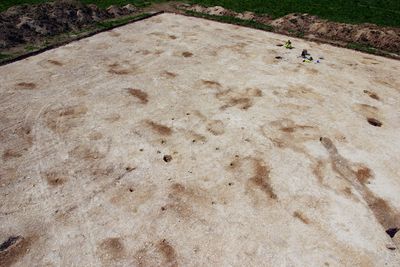Posthole
Jump to navigation
Jump to search



(CC [1]) Photo: Wessex Archaeology
Postholes can sometimes indicate the outline of buildings that no longer survive. In this photograph of excavations by Wessex Archaeology postholes have been discovered laid out in a circle, indicating a roundhouse occupied the site.
Postholes can sometimes indicate the outline of buildings that no longer survive. In this photograph of excavations by Wessex Archaeology postholes have been discovered laid out in a circle, indicating a roundhouse occupied the site.
In archaeology a posthole is a slot in the ground which held one end of a timber. Wooden structures might have their posts anchored in holes dug into the ground for stability. Once the timber was inserted the remainder of the hole would be refilled with earth. After a building has been demolished, the posthole remains and can be rediscovered through archaeological investigation, usually in the form of excavation. The timber could be removed or left to decay, each leaving a distinctive trace. Where samples of wood survive they can be radiocarbon dated to provide a date range for the construction of the building. In waterlogged soil conditions enough may remain that dendrochronology can be used to ascertain a much more accurate date.[1]
References
- ↑ Barker, Philip (1993). Techniques of Archaeological Excavation, third edition. London: Routledge. pp. 22–23. ISBN 0-415-15152-X.